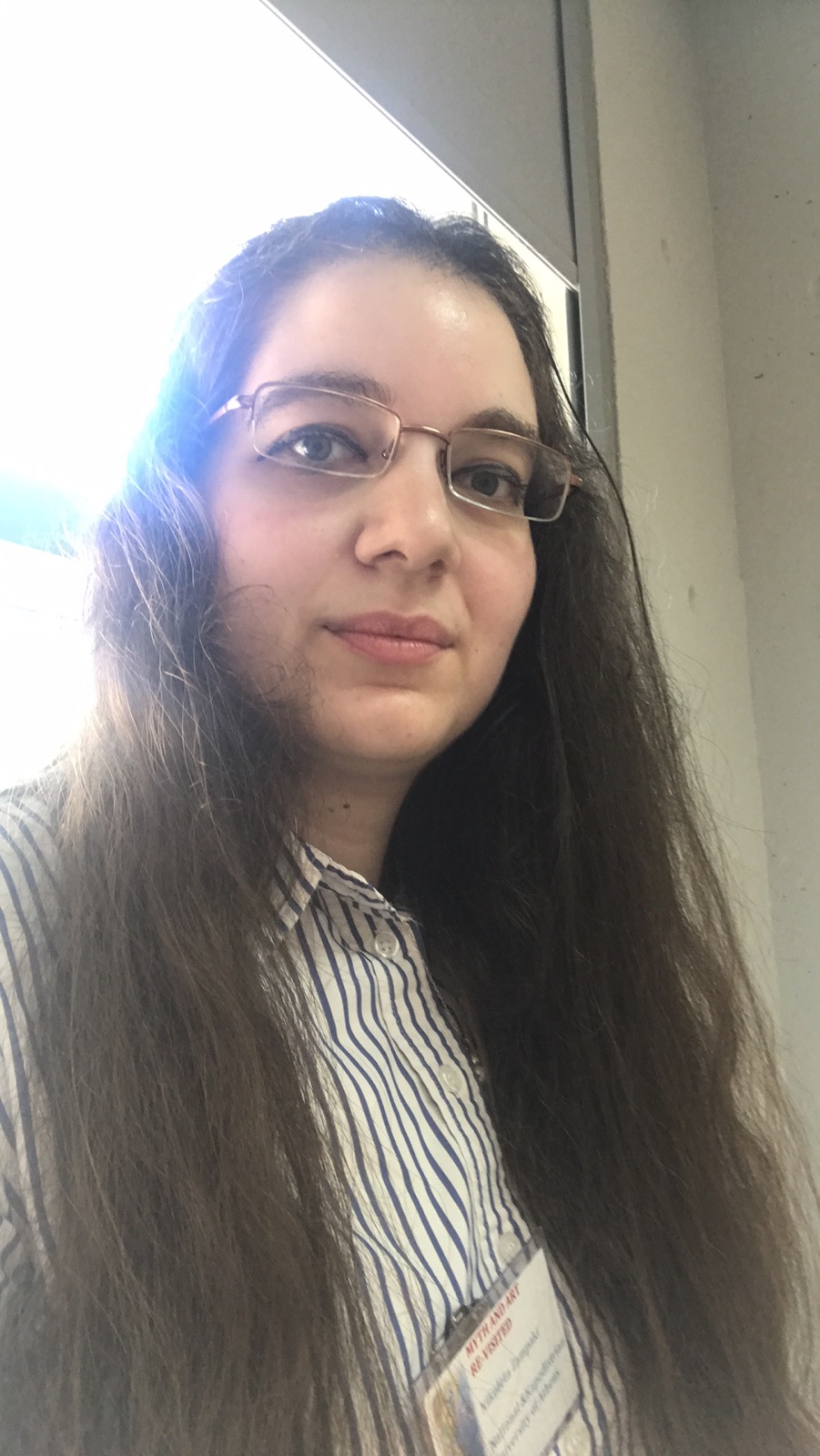“Eco-flaneurs of this changing world”
FOR SLOVENIAN VERSION OF THE INTERVIEW CLICK HERE
Nikoleta Zampaki is a PhD candidate in Modern Greek Literature at the National and Kapodistrian University of Athens, Faculty of Philology in Greece, and a junior fellow at the Center for Interdisciplinary and Intercultural Studies (CIIS) of Tübingen University, Germany. She is studying and researching in the field of environmental humanities, which includes zoopoetics and animal studies, post-humanities, literary theory, comparative literature, and the phenomenology of Maurice Merleau – Ponty. Driven by her desire to protect animals from various persistent dangers and threats, she has always been a passionate advocate for animal rights and animal rights movements. This motivates her to protect animal life by studying animals in both literary and cultural contexts.
Anja Radaljac: How do you (in your work) link the fields of environmentalism and animal rights?
Nikoleta Zampaki: First of all, I would like to thank you, dear Anja, for inviting me to give this interview and for disseminating it in your network. It is wonderful to connect with other scholars globally and indeed to have my interview translated into the Slovenian language. The main focus of my research and PhD thesis, which is a work in progress, is the field of zoopoetics. I am analyzing animal life in poetry, especially in the American and modern Greek poetry of the 19th and 20th centuries. It is wonderful to learn more about animal rights diachronically and to study the subject comparatively within various traditions.
AR: What can researching the literature of the past eras teach us? Why is it important in the context of animal rights? What about contemporary literary output?
NZ: I think that we have to examine the representations of animals in old literary texts (from the 12th to 19th century) closely in order to gain an insight into their role as being more than human counterparts, to distinguish their behavior from human behavior, as well as to discern different representations of animals in the texts (as a human’s friend, companion, enemy, etc.). The past eras have taught us diachronically that animals are present as human companions; there are many mentions of different species from the micro- as well as macro-cosmos, including horses, dogs, cats, birds, etc. When analyzing a text, one should focus on animal behavior, both the external and internal aspects, animal psychology, sound patterns, voices, even colors, and their interaction with humans.
Our analytical perspective draws on ontology, eco-phenomenology, metaphysics, etc. Throughout my upcoming book, titled Symbiotic Post-humanist Ecologies in Western Literature, Philosophy, and Art: Towards Theory and Practice, which I am co-editing with my supervisor, Prof. Peggy Karpouzou, we examine the concept of symbiosis within and beyond the human world, including animal life forms. Furthermore, I think that our current relationship with the world that extends beyond the human should be considered as symbiotic because we are all by nature in a symbiotic relationship with our environment. We are in an era of the eco-humanist and post-humanist novel; considering the interplay of the two, I feel that we are witnessing the dawning of another era, I call Symbiocene. Thus, our identity as global citizens in a changing world is shaped by the symbiosis we have with the world, which includes other animals. However, we have to protect the animals and not exploit them for profit or other uses.
In my country, the volume of current literary output in this field is small, because most texts do not focus on animals, their rights, etc. One of my favorite new titles is Το Κήτος (The Whale) by Ursula Foskolou. This book features short but grand stories of survival and danger, and human story lines full of passion, feeling, experience and symbolism. The animal life forms symbolize the dynamics and power of the human world and the different psychological stages that we go through in our lives.
AR: What are the most prevalent ways of incorporating non-human animals into the literary text in the context of Greek literature?
NZ: The most common way of incorporating non-human animals in literary texts in Greek literature is via symbols and metaphors. The stories, featuring animal agents who are either narrators or subjects of the narrative, thus reveal the animal world and the position of animals in a humanized world either as members of different species or as individuals. Animals have their own voices and our analysis enables us to listen to them and to articulate them in our texts and perception. There is always correspondence between humans and other animals, and this similarity is analyzed within the framework of eco-humanism. Animals are a part of our home (oikos); this underlying dynamic should drive the text and underscore our analysis. In a sense, animals create textuality and are as such part of our analysis. This entails the condition of complex involvement and at the same time fulfills the symbiotic intra- and extra- textual conditions.
AR: Could you give us some literary examples in the context of modern Greek literature that follow the idea of interspecies solidarity and/or building an interspecies community? What are some specifics in which non-human animals appear in such texts?
NZ: We examine the interspecies solidarity in prose such as Το Κήτος (The Whale) and Η Παναγία των Εντόμων (The Virgin Mary of Insects). The narratives are sometimes full of emotions, ontological concerns, anxiety for the future, as well as religious and metaphysical aspects of life and death. The poetry, for instance, of Angelos Sikelianos, praises animal life and takes inspiration from daily practices. Thus animal life is perceived and represented through metaphors, symbols, ontological and axiomatic statements. The poetic subject is in constant dialogue/interplay with the more-than-human world, always perceiving it, listening to it and taking on the role of an interlocutor by sharing anxieties, beliefs, etc. In Sikelianos’ poetry perspective animal life forms live symbiotically with the humans. All sides are perceived in terms of mutual respect and solidarity. You will soon be able to read more on Sikelianos’ zoopoetics in my PhD thesis, which will be translated into English.
AR: In which way does animal consciousness appear in modern Greek literature? Is there a tendency to establish non-human animals as first person homodiegetic narrators or does the third-person heterodiegetic narrator prevail? What do you believe is a better approach and why?
NZ: Animals are mindful agents having consciousness, feelings and can live either in animal communities or as individuals. They are multi-voiced beings in both poetry and prose. Moreover, they are anthropomorphized beings who care about human life, saving humans, even protecting them from evil. We can find many examples throughout modern Greek literature where animal consciousness drives the narrative or a poem (e.g. in Sikelianos’ poetry we can read a poem about an eagle, her consciousness, behavior and the interplay with human consciousness, etc.). We can see both tendencies: animals as narrators and subjects. The power of their voice is the locus that enables us to further and better understand the animal world.
I think that we can analyze the animal world through different perspectives, however I am adopting the eco-humanist perspective because it is neither reductionist to animals as non-human life forms nor is it textually restrictive. Animals create textuality and it will be wonderful to read post-humanist or civic narratives about them. It will be great to explore interdisciplinary fields such as environmental humanities, post-humanities, even robotics in order to further approach the animal world, and investigate any ensuing potentialities. Already many robots are being created that imitate the animal world but I am wary of the (un)ethical implications. The future is unpredictable and animals are civic agents as are humans, therefore we have to be careful when approaching the animal world and, indeed, be mindful of the underlying frameworks.
AR: Is it possible to define some similarities and differences between Greek and American literature in this sense?
NZ: Indeed, I could for instance compare Walt Whitman and Angelos Sikelianos’ zoopoetics. There are many similarities but also differences. Both of the poets praise, feel, even love different animals and their narrators are constantly in dialogue with the animals. I think that Whitman’s poetry comes across as more forceful than Sikelianos’. Namely, Whitman expresses his feelings and senses directly: he is in close contact with the animals in different circumstances and conditions such as in his daily life, practices and in close personal contact. In contrast, Sikelianos stresses the ontological aspects between animals and humans. His thought is more deeply concerned with the functional aspects of animals that his narrators are constantly in dialogue with and with whom they create a symbiotic partnership in time and space.
In conclusion, both poets are in dialogue on the topic of animal life forms and I think that observing it through an ecophenomenological lens results in seeing the embodied experience of animals as enclosed within the human experience, especially considering the term “universal flesh”, a Maurice Merleau – Ponty’s concept that unites different species in an ecosystem and then shapes not only the bio-cosmic perception of each poet, but also our own. All are eco-flaneurs of this changing world; in this sense, we are all its citizens and our identity is shaped by a multitude of interactions between us and other animals. My vision is to share with species other than my own, as I believe this will help us create a better world.

Anja Radaljac
Sem literarna in gledališka kritičarka ter prozaistka. Od leta 2016 se aktivno ukvarjam z naslavljanjem vprašanja ne-človeških zavestnih, čutečih bitij skozi izobraževalne vsebine. Leta 2016 sem izdala esejistični roman Puščava, klet, katakombe, ki skozi intersekcijsko obravnavo umešča vprašanje živali v širše družbeno polje. V okviru veganskega aktivizma sem izvajala predavanja po srednjih šolah v Sloveniji, priredila več predavanj in delavnic za nevegansko populacijo, izvajala pa sem tudi delavnice za veganske aktivistke_e. Od leta 2016 do začetka 2019 sem vodila izobraževalni video-blog ter Facebook stran Travožer.

